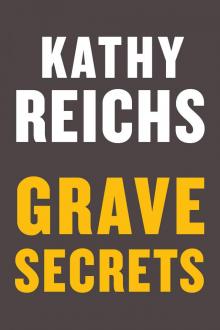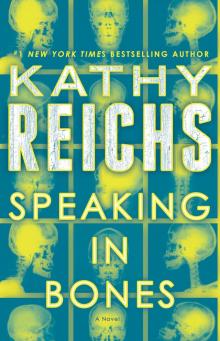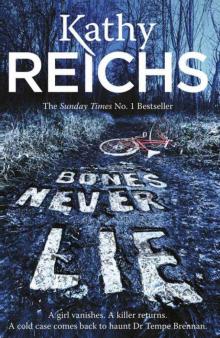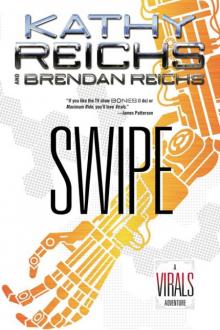- Home
- Kathy Reichs
Flash and Bones
Flash and Bones Read online
ALSO BY KATHY REICHS
SPIDER BONES
206 BONES
DEVIL BONES
BONES TO ASHES
BREAK NO BONES
CROSS BONES
MONDAY MOURNING
BARE BONES
GRAVE SECRETS
FATAL VOYAGE
DEADLY DÉCISIONS
DEATH DU JOUR
DÉJÀ DEAD
SCRIBNER
A Division of Simon & Schuster, Inc.
1230 Avenue of the Americas
New York, NY 10020
www.SimonandSchuster.com
This book is a work of fiction. Names, characters, places, and incidents either are products of the author’s imagination or are used fictitiously. Any resemblance to actual events or locales or persons, living or dead, is entirely coincidental.
Copyright © 2011 by Temperance Brennan, L.P.
All rights reserved, including the right to reproduce this book or portions thereof in any form whatsoever. For information address Scribner Subsidiary Rights Department, 1230 Avenue of the Americas, New York, NY 10020.
First Scribner hardcover edition August 2011
SCRIBNER and design are registered trademarks of The Gale Group, Inc., used under license by Simon & Schuster, Inc., the publisher of this work.
The Simon & Schuster Speakers Bureau can bring authors to your live event. For more information or to book an event contact the Simon & Schuster Speakers Bureau at 1-866-248-3049 or visit our website at www.simonspeakers.com.
DESIGNED BY ERICH HOBBING
Manufactured in the United States of America
1 3 5 7 9 10 8 6 4 2
Library of Congress Control Number: 2011024475
ISBN 978-1-4391-0241-1
ISBN 978-1-4391-1280-9 (ebook)
For
Declan Rex Reichs
Born July 1, 2010
Contents
Acknowledgments
Chapter 1
Chapter 2
Chapter 3
Chapter 4
Chapter 5
Chapter 6
Chapter 7
Chapter 8
Chapter 9
Chapter 10
Chapter 11
Chapter 12
Chapter 13
Chapter 14
Chapter 15
Chapter 16
Chapter 17
Chapter 18
Chapter 19
Chapter 20
Chapter 21
Chapter 22
Chapter 23
Chapter 24
Chapter 25
Chapter 26
Chapter 27
Chapter 28
Chapter 29
Chapter 30
Chapter 31
Chapter 32
Chapter 33
Chapter 34
Chapter 35
Chapter 36
ACKNOWLEDGMENTS
Flash and Bones would not have been possible without the help of Barry Byrd. Muchas gracias, Byrdman! I owe you.
Scott and Tiffany Smith invited me into their home and included me with the Race Week gang. Thanks. You created a new fan. Marcus Smith and Bryan Hammond welcomed me to the Charlotte Motor Speedway and answered endless questions about NASCAR and the track. Chad Knaus, Jimmie Johnson’s awesome crew chief, provided information on cars and race teams. Marty Smith of ESPN offered the perspective of a media insider. Bruton Smith’s hospitality in the owner’s suite was greatly appreciated.
Drs. Jane Brock, Patty McFeeley, and Mike Graham responded to my queries about ricin. Dr. William C. Rodriguez and Mike Warns answered a million questions each. Sergeant Harold (Chuck) Henson, Charlotte-Mecklenburg Police Department, helped with details on policing and law enforcement.
D. G. Martin shared an article on the history of stock car racing, and David Perry graciously donated Real NASCAR: White Lightning, Red Clay, and Big Bill France, by Daniel S. Pierce, University of North Carolina Press, Chapel Hill.
I appreciate the continued support of Chancellor Philip L. Dubois of the University of North Carolina-Charlotte.
I am grateful to my family for their patience and understanding. Amazing how they still put up with my grumpy phases.
Deepest gratitude to my agent, Jennifer Rudolph Walsh, and to my genius editors, Nan Graham and Susan Sandon. I also want to thank all those who work so very hard on my behalf, including: Katherine Monaghan, Paul Whitlatch, Rex Bonomelli, Kara Watson, Simon Littlewood, Gillian Holmes, Rob Waddington, Glenn O’Neill, Kathleen Nishimoto, Lauren Levine, Tracy Fisher, Michelle Feehan, Cathryn Summerhayes, and Raffaella De Angelis. I am also indebted to the Canadian crew, especially to Kevin Hanson, Amy Cormier, and David Millar.
And, of course, I am grateful to my readers. Without you, what’s the point?
If I have forgotten to thank anyone I am truly sorry. Though I tried to be careful, if the book has errors they are my fault.
FLASH AND BONES
LOOKING BACK, I THINK OF IT AS RACE WEEK IN THE RAIN. Thunderboomers almost every day. Sure, it was spring. But these storms were over the top.
In the end, Summer saved my life.
I know. Sounds bizarre.
This is what happened.
Bloated, dark clouds hung low to the ground, but so far no rain.
Lucky break. I’d spent the morning digging up a corpse.
Sound macabre? Just part of the job. I’m a forensic anthropologist. I recover and analyze the dead that present in less than pristine condition—the burned, mummified, mutilated, dismembered, decomposed, and skeletal.
OK. Today’s target wasn’t actually a corpse. I’d been searching for overlooked body parts.
Short version. Last fall a housewife vanished from her Cabarrus County home in rural North Carolina. A week ago, while I was away on a working vacation in Hawaii, a trucker admitted to strangling the woman and burying her body in a sandpit. Impatient, the local cops had sallied forth with shovels and buckets. They delivered the bones in a Mott’s applesauce carton to my employer, the Medical Examiner’s Office, in neighboring Mecklenburg County.
Yesterday, my aloha tan still glowing, I’d begun my analysis. A skeletal inventory revealed that the hyoid, the mandible, and all of the upper incisors and canines were missing.
No teeth, no dental ID. No hyoid, no evidence of strangulation. Dr. Tim Larabee, the Mecklenburg County medical examiner, asked me to have a second go at the sandpit.
Correcting screwups usually makes me cranky. Today I was feeling upbeat.
I’d quickly found the missing bits and dispatched them to the MCME facility in Charlotte. I was en route to a shower, a late lunch, and time with my cat.
It was 1:50 p.m. My sweat-soaked tee was pasted to my back. My hair was yanked into a ratty knot. Sand lined my scalp and undies. Nevertheless, I was humming. Al Yankovic, “White & Nerdy.” What can I say? I’d watched a YouTube video and the tune lodged in my head.
Wind buffeted my Mazda as I merged onto southbound I-85. Slightly uneasy, I glanced at the sky, then thumbed on NPR.
Terry Gross was finishing an interview with W. S. Merwin, the U.S. poet laureate. Both were indifferent to the conditions outside my car.
Fair enough. The show was produced in Philadelphia, five hundred miles north of Dixie.
Terry launched into a teaser about an upcoming guest. I never caught the name.
Beep! Beep! Beep!
The National Weather Service has issued a severe-weather warning for parts of the North Carolina piedmont, including Mecklenburg, Cabarrus, Anson, Stanly, and Union counties. Severe thunderstorms are expected to move through the area within the next hour. Rainfall of one to three inches is anticipated, creating the potential for flash flooding. Atmospheric condition
s are favorable for the development of tornadoes. Stay tuned to this station for further updates.
Beep! Beep! Beep!
I tightened my grip on the wheel and goosed my speed to seventy-five. Risky in a sixty-five-mile-an-hour zone, but I wanted to reach home before the deluge.
Moments later Terry was interrupted again, this time by a muted whoop-whoop.
My eyes flicked to the radio.
Whoop!
Feeling stupid, I checked the rearview mirror.
A police cruiser was riding my bumper.
Annoyed, I pulled to the shoulder and lowered my window. When the cop approached, I held out my license.
“Dr. Temperance Brennan?”
“Looking somewhat worse for wear.” I beamed what I hoped was a winning smile.
Johnny Law did not beam back. “That won’t be necessary,” indicating my license.
Puzzled, I looked up at the guy. He was mid-twenties, slim, with an infant mustache that appeared to be going nowhere. A badge on his chest said R. Warner.
“The Concord Police Department received a request from the Mecklenburg County medical examiner to intercept and divert you.”
“Larabee sent the cops to find me?”
“Yes, ma’am. When I arrived at the recovery site, you’d left.”
“Why didn’t he call me directly?”
“Apparently he couldn’t get through.”
Of course not. While digging, I’d locked my iPhone in the car to protect it from sand.
“My phone is in the glove compartment.” No need to alarm Officer Warner. “I’m going to take it out.”
“Yes, ma’am.”
The numbers on the little screen indicated three missed calls from Larabee. Three messages. I listened to the first: “Long story, which I’ll share when you’re back. The Concord PD received a report of a body at the Morehead Road landfill. Chapel Hill wants us to handle it. I’m elbow-deep in an autopsy. Since you’re in the area, I hoped you could swing by to check it out. Joe Hawkins is diverting that way with the van, just in case they’ve actually got something for us.”
The second message was the same as the first. Ditto the third, but more terse. It ended with the inducement: You’re a champ, Tempe.
A landfill in a storm? The champ was suddenly not so chipper.
“Ma’am, we should hurry. The rain won’t hold off much longer.”
“Lead on.” I could not have said this with less enthusiasm.
Warner returned to his cruiser, whoop-whooped, then pulled into traffic. Inwardly cursing Larabee, Warner, and the landfill, I palm-slapped the gearshift and followed.
Traffic on I-85 was unusually heavy for Thursday, midafter-noon. As we approached Concord, I could see that the Bruton Smith Boulevard exit ramp was a parking lot.
And realized what a nightmare this little detour of Larabee’s would be.
The Morehead Road landfill is back-fence neighbor to the Charlotte Motor Speedway, a major stop on the NASCAR circuit. Races would be held there this weekend and next. Local print and broadcast coverage was extensive. Even I knew that tomorrow’s qualifying would determine which lucky drivers made the cut for Saturday’s All-Star Race.
Two hundred thousand avid fans would pour into Charlotte for Race Week. Looking at the sea of SUVs, campers, pickups, and sedans, I guessed that many had already hit town.
Warner rode the shoulder. I followed, ignoring the hostile glares of those cemented in the logjam.
Lights flashing, we snaked through the bedlam on Bruton Smith Boulevard, past the dragway, the dirt track, and a zillion fast-food joints. On the sidelines, the tattooed and tank-topped carried babies, six-packs, coolers, and radios. Vendors sold souvenirs from folding tables beneath improvised tents.
Warner looped the surrealistic geometry of the Speedway itself, made several turns, then rolled to a stop outside a small structure whose siding might once have been blue. Beyond the building loomed a series of mounds resembling a Martian mountain range.
A man emerged and issued Warner a yellow hard hat and a neon orange vest. As they talked, the man pointed at a gravel road rising sharply uphill.
Warner waited while I received my safety gear, then we proceeded up the slope. Trucks rumbled in both directions, engines churning hard going in, humming going out.
When the road leveled, I could see three men standing by an enormous Dumpster. Two wore coveralls. The third wore black pants and a long-sleeved black shirt over a white tee. Joe Hawkins, longtime death investigator for the MCME. All three featured gear identical to that lying on my passenger seat.
Warner nosed up to the Dumpster and parked. I pulled in beside him.
The men watched as I got out and donned my hard hat and vest. Fetching. A perfect complement to my current state of hygiene.
“We gotta quit meeting like this.” Joe and I had parted at the sandpit barely an hour earlier.
The older man stuck out a hand. “Weaver Molene.” He was flushed and sweating and filled his coveralls way beyond their intended capacity.
“Temperance Brennan.” I’d have skipped the handshake, given the black moons under Molene’s nails, but didn’t want to be rude.
“You the coroner?” he asked.
“I work for the medical examiner,” I said.
Molene introduced the younger man as Barcelona Jackson. Jackson was very thin and very black. And very, very nervous.
“Jackson and I work for the company that manages the landfill.”
“Impressive pile of trash,” I said.
“Site’s got a capacity of over two and a half million cubic meters.” Molene ran a dingy hankie across his face. “Friggin’ weird Jackson stumbled onto the one square foot holding a stiff. Or maybe not. Probably dozens out there.”
Jackson had mostly kept his eyes down. At Molene’s words, he raised and then quickly dropped them back to his boots.
“Tell me what you found, sir.”
Though I spoke to Jackson, Molene answered.
“Probably best we show you. And quick.” He pocket-jammed the hankie. “This storm’s coming fast.”
Molene set off at a pace I would have thought impossible for a man of his bulk. Jackson scampered after. I fell into line, paying attention as best I could to the uneven footing. Warner and Hawkins brought up the rear.
I’ve excavated in landfills, am familiar with the aroma of eau de dump, a delicate blend of methane and carbon dioxide with traces of ammonia, hydrogen sulfide, nitrogen, hydrogen chloride, and carbon monoxide added for spice. I braced for the stench. Didn’t happen.
Good odor management, guys. Or maybe it was Mother Nature. Wind swirled dirt into little cyclones and tumbled cellophane wrappers, plastic bags, and torn paper across the landscape.
Our course took us the length of the active landfill, down a slope, then around a series of what appeared to be closed areas. Instead of raw earth, the tops of the older mounds were covered with grass.
As we walked, the rumble of trucks receded, and the whine of fine-tuned engines grew louder. Based on the changing acoustics, I figured the Speedway lay over a rise to our right.
After ten minutes, Molene stopped at the base of a truncated hillock. Though tentative grass greened the top, the side facing us was scarred and pitted, like a desert butte gouged by eons of wind.
Molene said something I didn’t catch. I was focused on the exposed stratigraphy.
Unlike the sandstone or shale that make up metamorphic rock, the mound’s layers were composed of flattened Pontiacs and Posturepedics, of squashed Pepsis, Pop-Tarts, Pringles, and Pampers.
Molene pointed to a crater in a brown-green layer eight feet above our heads, then to an object lying about two yards off the base of the mound. His explanation was lost to a clap of thunder.
Didn’t matter. It was obvious Jackson’s “stiff” had dropped from the mound, probably dislodged by the previous day’s storm.
I crossed to the thing and squatted. Molene, Warner, and Hawkins clu
stered around me but remained standing. Jackson kept his distance.
The object was a drum, approximately twenty inches in diameter and thirty inches high. Its cover lay off to one side.
“Looks like a metal container of some kind,” I said without looking up. “It’s too rusted to make out a logo or label.”
“Flip it,” Molene shouted. “Jackson and I turned the thing bottom up to protect the stuff inside.”
I tried. It weighed a ton.
Hawkins squatted, and together, we muscled the drum upright. Its interior was filled with a solid black mass.
I leaned close. Something pale was suspended in the dark fill, but the pre-storm gloom obscured all detail.
I was reaching for my Maglite when lightning sparked.
A human hand flashed white in the electric brilliance.
Dissolved to black.
IRAN MY BEAM OVER THE INKY MATRIX.
The white inclusion was unquestionably a human hand.
The fill was rock-hard but crumbling at the exposed edges. I suspected asphalt. The size of the drum suggested a thirty-five-gallon capacity.
Thirty seconds of discussion, and we had a plan.
Warner and Jackson would stand guard while the rest of us returned to the management office. Though Jackson’s look said he’d rather be elsewhere, he offered no protest.
The clouds burst as Hawkins, Molene, and I picked our way back. We arrived mud-coated and thoroughly soaked.
To my dismay, two vehicles waited a short distance down the dirt road, motors idling, wipers slapping. I recognized the driver of the Ford Focus.
“Sonofabitch,” I said.
“What?” Behind me, Molene was breathing hard.
“Reporters.” I waved a hand in the direction of the cars.
“I didn’t talk to no one. I swear.”
“Their scanners probably picked up the radio transmission from the cops to the ME.”
“You’re kidding.”
“It’s Race Week.” I made no attempt to hide my irritation. “A murder at the Speedway would make splashy headlines.”
Seeing us, the reporters emerged from their cars and slip-slid to the checkpoint. One was a mushroom-shaped man holding an umbrella. The other was a woman in a slicker and pink vinyl boots.

 Two Nights
Two Nights The Bone Collection: Four Novellas
The Bone Collection: Four Novellas Fatal Voyage
Fatal Voyage 206 Bones
206 Bones Bones to Ashes
Bones to Ashes Terminal
Terminal Monday Mourning
Monday Mourning Flash and Bones
Flash and Bones Cross Bones
Cross Bones Devil Bones
Devil Bones Break No Bones
Break No Bones Swamp Bones
Swamp Bones Déjà Dead
Déjà Dead Shock
Shock Spider Bones
Spider Bones Death Du Jour
Death Du Jour Grave Secrets
Grave Secrets Trace Evidence: A Virals Short Story Collection
Trace Evidence: A Virals Short Story Collection Bones on Ice
Bones on Ice The Bone Code
The Bone Code Bones in Her Pocket
Bones in Her Pocket Seizure:
Seizure: Speaking in Bones
Speaking in Bones Deadly Decisions
Deadly Decisions Spike
Spike Bones Never Lie
Bones Never Lie Bones of the Lost
Bones of the Lost Virals 03.5 - Swipe
Virals 03.5 - Swipe Exposure
Exposure A Conspiracy of Bones
A Conspiracy of Bones Shift (tory brennan)
Shift (tory brennan) Bones of the Lost: A Temperance Brennan Novel tb-16
Bones of the Lost: A Temperance Brennan Novel tb-16 Virals tb-1
Virals tb-1 Bones Are Forever tb-15
Bones Are Forever tb-15 Code tb-3
Code tb-3 Seizure tb-2
Seizure tb-2 Deadly Descisions
Deadly Descisions Spider Bones: A Novel
Spider Bones: A Novel